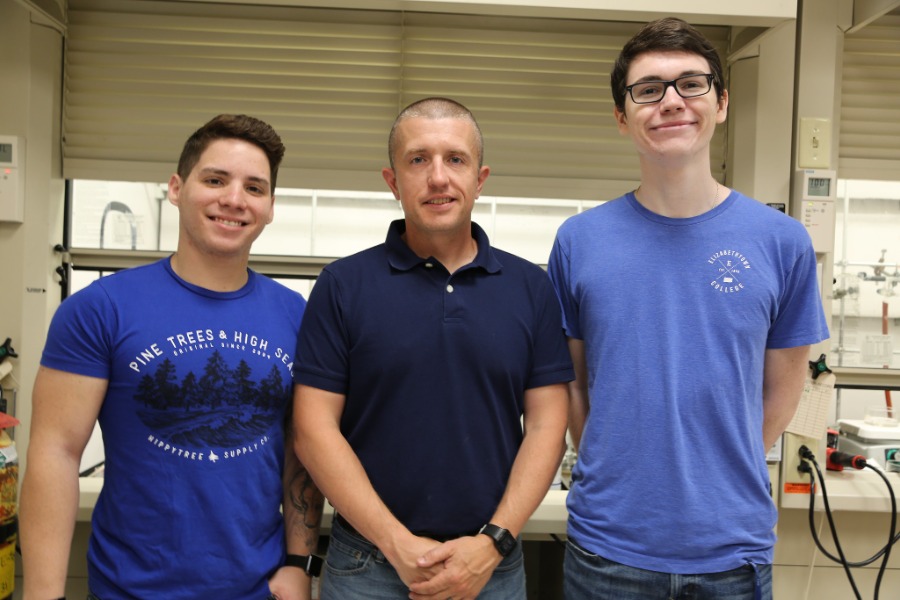Elizabethtown College students Brandon Molina ’23 and Nicholas Erisman ’24 are observing luminescent properties in metal-organic frameworks to create sensors capable of detecting volatile, disease-causing organic compounds in common household items. Their research aims to help individuals identify these compounds in their homes and limit contact with these harmful substances.
The independent student research and collaboration with an Etown faculty mentor is part of the Summer Creative Arts and Research Program (SCARP) program.
Title of Research:
Luminescence from Metal-Organic frameworks: structural modifications and molecule uptake
Student Researchers:
Brandon Molina ’23 (Biochemistry and Molecular Biology major)
Nicholas Erisman ’24 (Biochemistry and Molecular Biology major)
Faculty Mentor:
Jeffrey Rood, Professor of Chemistry
What are you researching?
Brandon: In this project, the UiO-66 structure will be employed to detect certain analytes such as VOCs (Volatile Organic Compounds). These compounds are found in common household items such as aerosol paint, solvents, upholstery fabrics, carpets and adhesives, varnishes, vinyl floors, cleaning chemicals, air fresheners, cosmetics, fuel oil, moth balls, and these species are known to cause cancer. Thus, optical sensors that provide a visual change upon detection of a target species offer advantages as they can be portable and used in the field. UiO-66 will be synthesized and exposed to various types of alcohols with the purpose of observing its luminescent properties in the presence of different alcohols with the goal of developing a sensor that can detect various types of analytes in the presence of different solvents.
Nicholas: This research focuses on metal-organic frameworks (MOF) and on the synthesis of new MOFs, as well as the investigation of the chemical properties of new and known MOFs. MOFs incorporate metal complexes with organic linkers to form an extended lattice structure. These crystalline lattices have pores that can be filled with solvent and depending on the metal used and the solvent in the pore, some of the properties of the MOF can change. Because the properties of a MOF can change based on the solvents present, it is predicted that a MOF can be used to detect if a specific solvent is present within the solution.
Why did you choose this topic?
Brandon: I chose this topic since it can be a way to innovate the chemical sensing field in science, which can lead to the development of devices that detect certain species of chemicals such as VOC (Volatile Organic Compounds) which are known to cause cancer and other respiratory diseases.
Nicholas: I found this topic to be very interesting. This research topic included some organic chemistry, which I had already taken the corresponding classes for and enjoyed the challenge that is included in these courses. The topic also included some inorganic chemistry. I was enrolled in an inorganic chemistry class when I was first looking into SCARP. This connection allowed me to have a better understanding of this project than most, and this strong understanding of the research piqued my interest in the research topic.
What is the most interesting aspect of this research?
Brandon: The interesting aspect of this research is applying what I have learned into this research, compiling different ideas to make informed decisions, and remaining calm under pressure when required.
Nicholas: The most interesting part of this research to me is the diversity of MOFs that exist. There are many different metal atoms that can be used in the metal complexes, and there are many different ligands that can be bonded to the metal atom of the complex. There is also a lot of diversity among the organic linkers that can be used. This broad spectrum of potential combinations leaves many opportunities to explore the unknown and improve our understanding of the world around us.
How has your faculty mentor helped you?
Brandon: Working with Dr. Rood has to be one of the greatest pleasures of my scientific career; he truly embodies what a leader should be. He not only encourages you to try your best but also supports you on outside endeavors. He has become an important part of my career here at Etown and I would work for him for as long as I am allowed to.
Nicholas: Dr. Rood is an excellent mentor. Dr. Rood would frequently check-in as we worked and see the progress that we have made as we performed our research. We would then discuss some of the observations and evaluate any changes that might be necessary to change. This method allowed me to build upon my own lab skills as well as my confidence, in addition to increasing my understanding of the underlying chemistry.
Hear from the faculty mentor – Jeffrey Rood
“Brandon and Nick work on different facets of a broad research project that has been going on in the lab for several years,” Rood said. “They both have made nice progress in their respective areas and pick up on things quickly. They work well together, and it has been a fun dynamic in the lab so far this summer.
“Broadly speaking, they are both working on expanding on previous results that other SCARP students have obtained in an effort toward increasing the likelihood of practical applications with detection of small molecules with MOFs.”

